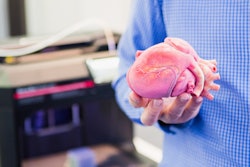
Just one high dose of radiation to the heart can significantly reduce episodes of ventricular tachycardia, an irregular rapid heart rhythm that can be deadly, according to a study presented this week at the American Society for Radiation Oncology (ASTRO) meeting in Chicago.
Ventricular tachycardia occurs when the lower chambers of the heart beat too quickly and become out of sync with the upper chambers. The actions interfere with blood flow and increases the risk of sudden cardiac death.
Patients typically are given implanted devices with defibrillators that kickstart the heart back into a normal rhythm. Another option is to undergo catheter ablation procedures, during which a catheter is inserted into the heart and used to create scars in the part of the damaged heart muscle that is causing the dysfunctional electrical signals.
At ASTRO 2019, researchers from the Washington University School of Medicine in St. Louis presented results from a study that enrolled 19 patients with ventricular tachycardia who were severely ill and had not responded to other standard treatments. Subjects underwent a noninvasive outpatient procedure that uses electrocardiograms and CT images to pinpoint the origin of the arrhythmia. The results are used to create 3D visual and electrical maps of the heart to guide radiation therapy.
"Radiation therapy is a last line of defense for these patients, who are often too unwell to undergo additional traditional therapies to control heart arrhythmias," said Dr. Clifford Robinson, an associate professor of radiation oncology and of cardiology, in a statement by ASTRO. "It provides hope for patients with dangerous rhythms who have run out of options."
Physicians targeted the problem area of the heart with a single high-dose beam of radiation. The procedure often takes less than 10 minutes and requires no anesthesia or hospitalization. In fact, patients can go home soon after treatment.
Through this approach, Robinson and colleagues were able to reduce tachycardia episodes in approximately 80% of their subjects for at least two years after only one treatment. At one-year follow-up, overall survival was 72%; after two years, overall survival was 52%.
"These numbers are encouraging given the condition of the patients, who are too sick to undergo any more catheter ablation procedures," Robinson added. "Given the relative novelty of this treatment approach, we are continuing to follow our patients closely."


















